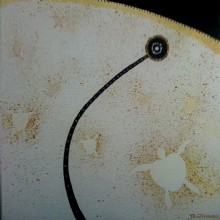I am studying graphic design and was wanting to find something that related to my area of study. I was recently told about an Australian Indigenous Strategy and Design Company based in Sydney named Balarinji Designs Studio that is part of the Jumbana Group. It produces designs for a wide range of mediums and has been involved in commissioning and creating designs for Qantas jumbo jets and other commercial material. They were established in 1983 by John Moriarty and Ros Moriarty, and it says on their website that they deliver 'groundbreaking commercial and non-profit outcomes in relation to Aboriginal Australia'.
The jet design was inspired by the dramatic colors of sunset at Uluru and represents one of the many dreamtime stories. I like the bold use of colour and strong line work; as well as how the design blends ancient patterns and symbols with modern technology. It is interesting that both Aboriginal and non-Aboriginal artists transferred the design from computer to the airplane's exterior.
The studio was also commissioned by The International Cricket Council (ICC) to create the ICC Cricket World Cup 2015 logo (shown above). The design combines both Australian and New Zealand cultural motifs so as to reflect the two indigenous countries' cultural identities. I think this is an attractive and dynamic logo which captures the cultural influences of the two countries in a harmonious way and also has a feeling of celebration with the bright colours used.











